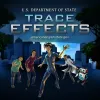Take a look inside 4 images
Trace Effects
Pros: Clear speech and the ability to replay conversations makes the game easy to understand.
Cons: Technical issues like long load times and floaty controls take away from the story and learning.
Bottom Line: A positive story and interesting word-collection challenge help students develop skills in English.
Trace Effect includes a rich teacher's resource linking to lessons, websites, and activities students can use to further their involvement in the game. Trace Effects will probably function best as an enrichment or practice activity, though -- it doesn't do much actual teaching, and it relies on students having a pretty solid grasp of the English language.
Teachers could also encourage students to do some writing of their own, creating graphic novels like the ones on the website to illustrate their own adventures in time travel. There could be some excellent opportunities for cultural discussion here, particularly if the time travel also involved traveling through space, allowing students to document the cultural difficulties an American student might have in their own home country, for example.
Trace Effects is an online 3-D exploration and logic puzzle game about civic participation designed for English-language learners (ELLs). Players control Trace, a time-traveling college student who’s sent back to the present from the year 2045. He arrives in our time and must undertake several missions to help people accomplish goals that improve life in the present. To complete his missions, Trace must collect two kinds of resources: verbs and items. Verbs appear in each level as floating words, such as deliver, and once Trace walks into them, they disappear from the game world and reappear in his inventory. Items (including a candle) appear as floating objects or are received from other characters in the story. As Trace completes missions, he hears back from his friends in the future about the positive effects his actions are having on their world. For example, when Trace helps a young activist document his efforts to clean a river, that activist becomes a famous photographer and spokesperson for the environment in Trace's time.
Kids play each chapter of Trace Effects to unlock both the next chapter and part of a graphic novel summarizing each completed chapter. At the end of each chapter, kids have access to language practice activities. They also have the option to print a chapter completion certificate listing the language skills they used in the game. There is currently a known technical issue that means players can't advance levels automatically and have to send an email to the developer to access the next chapter.
The game's story is silly, but it's also sincere and compelling. Characters speak clearly and slowly, and the game always offers students the opportunity to replay and rehear conversations, making the game adaptable to different ability levels. Better still, Trace Effects manages to cram quite a bit of learning in a simple game mechanism. For example, players make choices about how to proceed in conversations in a mechanism reminiscent of popular adventure games like Mass Effect. The game also displays emotions so you can gauge characters' responses to your conversation. When delivering sandwiches, for example, walking up to a character and demanding "What is your name?" results in them becoming annoyed and asking, "Why do you want to know?" Asking if they ordered a sandwich, on the other hand, results in them becoming happy and saying, "Why yes, I did."
Trace Effects has a lot going for it -- simple game mechanisms that teach English language, cultural awareness, and civic responsibility all at once. There are also some problems: The levels take about a minute to load and won't advance automatically, and the controls are annoying in enclosed quarters. Older students might become bored by the point-and-click nature of many of the game's quests, as well.












